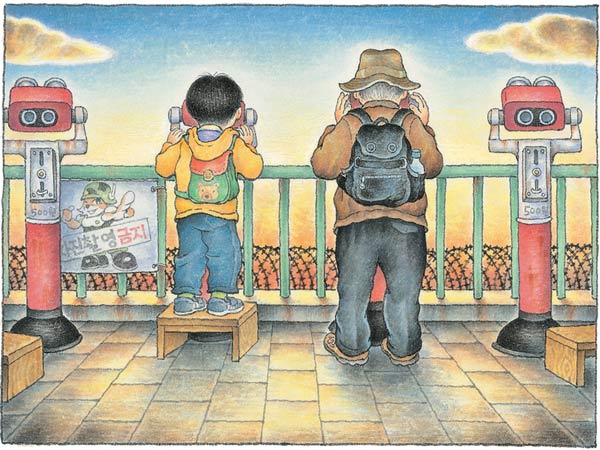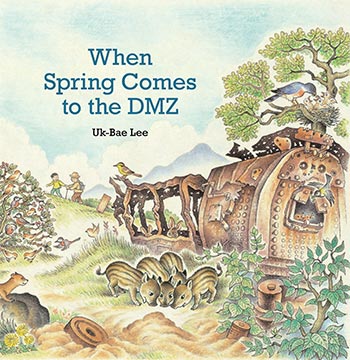Subtotal: $
Checkout
While adults debate border walls, one artist is planting seeds in the hearts of children who, he believes, will one day tear them down. This March Plough releases an English edition of Uk-Bae Lee’s picture book, When Spring Comes to the DMZ. With the Korean Peninsula making headlines once again, we asked Lee for an update.
Already a subscriber? Sign in
Try 3 months of unlimited access. Start your FREE TRIAL today. Cancel anytime.
Why a children’s book about the DMZ?
With other authors from Korea, China, and Japan, I started the “Picture Book Peace Project” to help children envision a more peaceful world. But when I heard the word “peace,” into my mind flashed the brutal scenery of the DMZ, which is of course the opposite of peace, an image of war. The DMZ is like a wound scratched by a giant monster across the back of the Korean Peninsula, dividing South and North with sharp images of razor wire and ochre-colored earth that bring to mind the blood that has flowed there.
So how demilitarized is the DMZ really?
“Demilitarized zone” means an area free of weapons, but in actual fact there are still hundreds of thousands of landmines buried there and soldiers armed with high-tech weapons on either side. However – and this is a paradox – without the meddling of people the flora and fauna within the DMZ has flourished. The area has even been called a paradise for endangered plants and animals. It is, more accurately, a refuge of last resort. Still, we can see the irony that nature has benefitted from the troubles of humankind. The DMZ should make us think and reflect not only on the relationships between people, but also on the coexistence of humans and nature.
You visited the DMZ to create this book. What was most memorable?
The red-crowned crane family and the wild geese flying south over the barriers are unforgettable. The scenery was real, but I had a strange feeling of unreality: with such a tragic human history, how could the landscape be so beautiful?
What has changed in the DMZ as the result of recent meetings between the leaders of the two Koreas?
The gates are still closed and there is no freedom to travel back and forth. But some guard posts on both sides have been demolished and preparations are underway to reconnect the railroad and highway. The progress has been nothing short of a miracle, and people who love peace should continue to encourage these efforts so the seventy-year division of North and South Korea can end and an era of peace can begin.
At the end of the book, we see an old man and his grandson throw open the DMZ’s gates and embrace their family from North Korea. When will that day come?
A peaceful world where separated families will meet and people can come and go freely will certainly come, because eighty million Korean people in North and South and overseas are earnestly wishing for peace. Perhaps the time of peace has started already, but a lot of work needs to be done to achieve “a peace that cannot be turned back from” and a world where war is no longer a threat. One picture book cannot change the world right away, but if it can leave a small impression, if it can move hearts just a little, then couldn’t those hearts together change the world bit by bit?
In writing your book, were you also thinking of other walls such as the Gaza Strip barrier and the US–Mexico border?
Walls become firmer as more people despair of an end to the division. If we want to break down the walls, we need to first bring down the walls in our own hearts. A physical wall cannot be built in one morning or come down overnight, but the walls in the heart can come down all of a sudden.
Once we bring down the walls in our hearts we can start something small to help knock down the real walls. There is a Korean saying that “constant dripping wears away stone.” The raindrops continually dripping down from the roof make a hole in the stone terrace. If we do not give up our dream for peace and are persistent in our efforts, the real walls will come down eventually.

Artwork from Uk-Bae Lee’s book
Interview conducted and translated by Chungyon Won, January 3, 2019.
Images by Uk-Bae Lee. Used by permission.

Get the book: Korea’s demilitarized zone has become an amazing accidental nature preserve that gives hope for a brighter future for a divided land.
Already a subscriber? Sign in
Try 3 months of unlimited access. Start your FREE TRIAL today. Cancel anytime.

























Becki Hawkins
What a wonderful book! Blessings to you and all who buy and read and share your book🙏🙏